- Clinical Technology
- Adult Immunization
- Hepatology
- Pediatric Immunization
- Screening
- Psychiatry
- Allergy
- Women's Health
- Cardiology
- Pediatrics
- Dermatology
- Endocrinology
- Pain Management
- Gastroenterology
- Infectious Disease
- Obesity Medicine
- Rheumatology
- Nephrology
- Neurology
- Pulmonology
Edema of the Hands: A Photo Essay
Edema of the hands has numerous etiologies: leukocytoclastic vasculitis, puffy hands from HCV infection, DVT, lymphedema, trauma
The violaceous, nonpruritic eruptions seen here on the hand of a 62-year old man appeared 2 weeks earlier and affected the arms and legs as well. Hemorrhagic bullae and targetoid lesions are also seen. Punch biopsy of the bullae reveals a mixed, predominantly neutrophilic, perivascular infiltrate obliterating vessel walls, with fibrinoid necrosis, leukocytoclasis, erythrocyte extravasation, and overlying epidermal necrosis. These findings support the diagnosis of acute leukocytoclastic vasculitis.
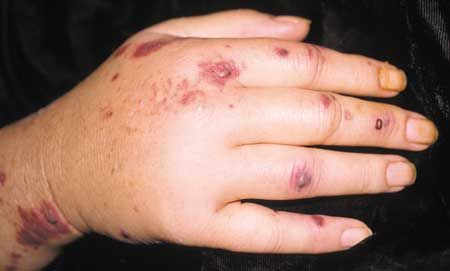
Courtesy of S Shane Rabin, BS, Jacob Dudelzak, MD, Jeffrey R. Lee, MD, and Daniel Sheehan, MD.
Click here for the next image
Bilateral "puffy hands" are a common clinical feature of hepatitis C virus (HVC) infection. A history of intravenous drug use should be explored and location of injections clearly identified. The puffy hands here are those of a former heroin addict with HCV infection. The hand edema begins as pitting edema, followed by thickening and fibrosis of the subcutaneous tissue.
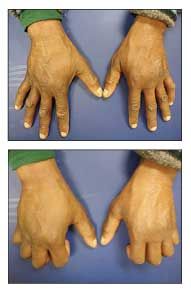
Courtesy of James Studdiford, MD, Kathleen Lamb, Amber Stonehouse, MD.
Click here for the next image
Focal ring constrictions of the third, fourth, and fifth fingers are seen here on the hand of a full-term newborn infant; secondary edema and discoloration are also seen. The cause of such bands is debated. One hypothesis implicated localized germ cell failure, possibly due to hypoxia. A subsequent theory suggested the deformity was caused by early rupture of the amnion, with resulting bands that could restrict and impair growth of an extremity.
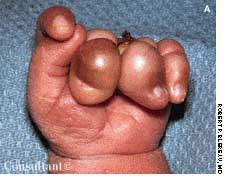
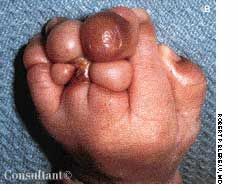
Courtesy of Robert P. Blereau, MD.
Click here for the next image
Arm and hand edema are clinical signs of deep vein thrombosis, with associated tenderness, erythema, and warmth. Left subclavian-axillary vein thrombosis occurred in this patient after central line placement. Thrombosis may occur in up to 72% of central venous catheter placements.

Courtesy of Henry Schneiderman, MD.
Click here for the next image
Lymphedema, seen here in the right arm and hand of a female patient after axillary lymph node dissection, results from accumulation of proteinaceous fluid in interstitial tissue; with time, there is inflammation and fibrosis of subcutaneous tissue. Slowed lymphatic transit time induces lipogenesis and fat deposition. Fibrocytes are then activated and, with time, connective tissue overgrowth occurs as fibrosis ensues.
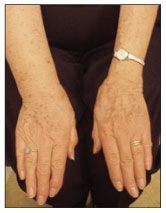
Courtesy of Fawad Shaheen, MD.
Click here for the next image
Fracture of the fifth metacarpal neck resulting from trauma with a closed fist caused edema in a boxer's hands.
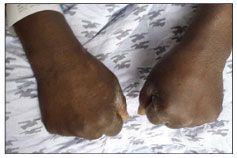
Courtesy of D. Brady Pregerson, MD.
Click here to return to the first image.
